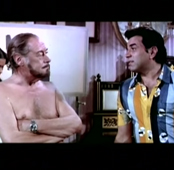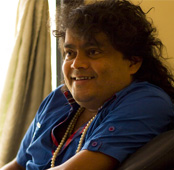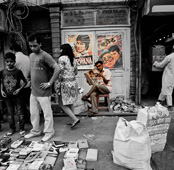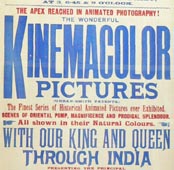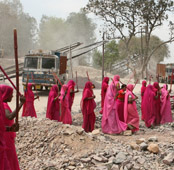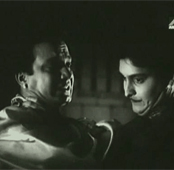-
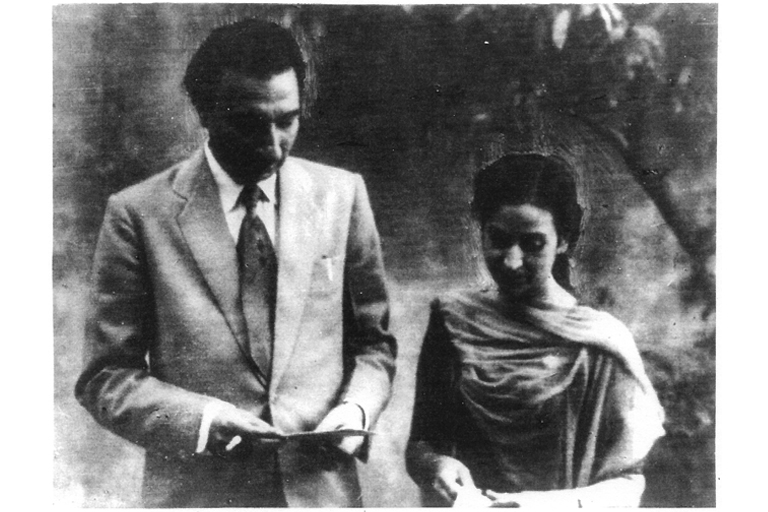 Sahir and Amrita Pritam: A relationship which was defined largely by silence. Image courtesy: Imroz
Sahir and Amrita Pritam: A relationship which was defined largely by silence. Image courtesy: Imroz -
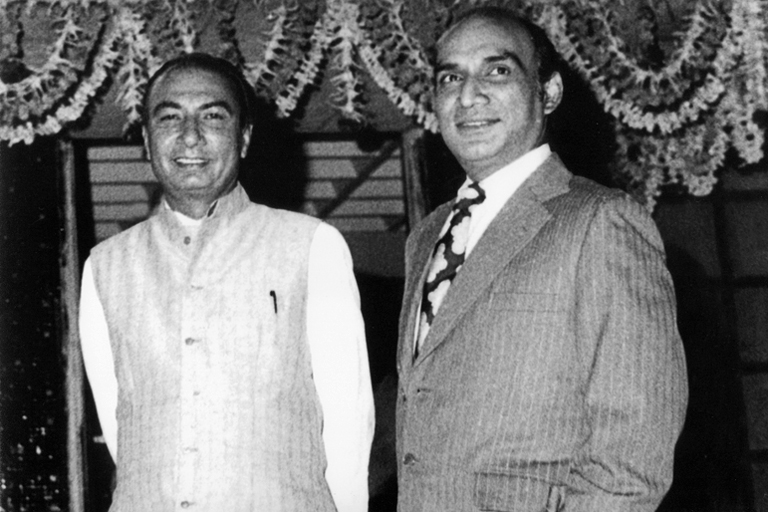 Sahir (L) and Yash Chopra (R):Friends for life. Sahir worked as lyricist on each of Yash's films, beginning with Dhool Ka Phool (1959). Image courtesy: Yash Chopra
Sahir (L) and Yash Chopra (R):Friends for life. Sahir worked as lyricist on each of Yash's films, beginning with Dhool Ka Phool (1959). Image courtesy: Yash Chopra -
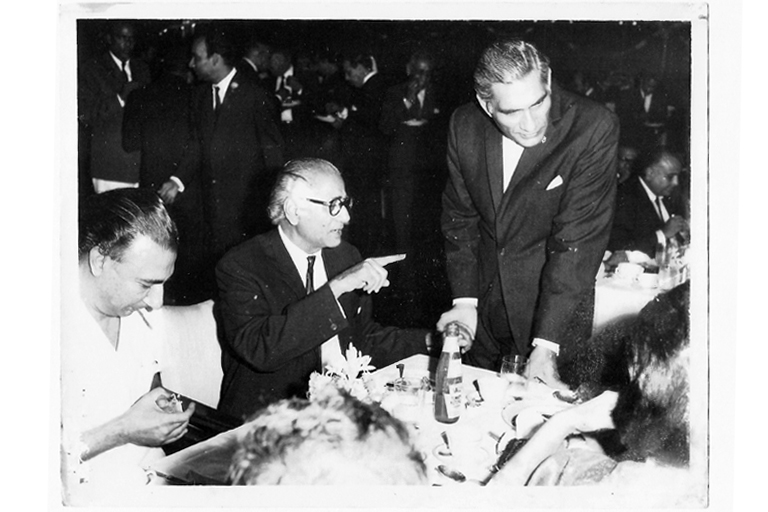 Sahir (extreme left) with B.R. Chopra (standing). The two men were on a similar wavelength, using Hindi cinema as a medium to air their views on matters of social importance. Image courtesy: Ravi Chopra/B.R.Films
Sahir (extreme left) with B.R. Chopra (standing). The two men were on a similar wavelength, using Hindi cinema as a medium to air their views on matters of social importance. Image courtesy: Ravi Chopra/B.R.Films
Here are two excerpts from a book on the life and work of poet and lyricist Sahir Ludhianvi, by Akshay Manwani.
FINDING LOVE IN THE SHADOW OF OEDIPUS
Tumhaarey ahad-e-wafaa ko main ahad kya samjhoon?
Mujhe khud apni mohabbat ka aitbaar nahin
(How do I believe your promises of fidelity?
When my own ability to love remains in doubt)
The great Punjabi poet and writer Amrita Pritam once told Uma Trilok, who authored Amrita-Imroz: A Love Story, of the following conversation involving Sahir and her:
Sahir happened to ask Amrita, ‘Why don’t the two of us go and live in China?’
Amrita, puzzled by Sahir’s sudden suggestion of moving to China, sought an immediate explanation. ‘What will we do living in China?’
‘We shall write poetry,’ replied Sahir, rather vaguely.
Amrita shot back, ‘We can write poetry here without going to China.’
‘Yes we can, but if we go to China we will never come back,’ said Sahir.
It was, as Amrita told Uma, Sahir’s idea of proposing a lifetime together with her.
He was that kind of man.
*
One of the most intriguing aspects of Sahir’s life was his liaison with Amrita Pritam. Amrita met Sahir sometime around 1944 in Preet Nagar, a village between Lahore and Amritsar. She was at this time married to Pritam Singh, who was an editor, but theirs was not the best of marriages. Husband and wife were known to be on totally different wavelengths from the very beginning.
Amrita, in her mid-twenties at the time, had come to Preet Nagar to attend a mushaira which was being attended by Punjabi and Urdu poets. It was here that she saw and heard Sahir for the first time. She was immediately smitten by him. ‘I do not know whether it was the magic of his words or his silent gaze, but I was captivated by him,’ writes Amrita of the moment.
The mushaira ended only after midnight following which the guests bid goodbye to each other. The next morning they were supposed to go to the neighbouring township of Lopoki, from where a bus had been organized to take them back to Lahore.
However, the following morning they discovered that it had rained the previous night and the road they had to take to reach Lopoki had been rendered slippery and hazardous. Apparently, the sky had turned cloudy during the mushaira itself and it had started drizzling by the time the mushaira had drawn to a close. Amrita saw the hand of fate in all of this as she recalls, ‘Now, when I look back on that night, I can say that destiny had sown the seed of love in my heart which the rain nurtured.’
Desperate to go to Lopoki, the guests made their way ahead cautiously. It was in these circumstances that Amrita experienced her love blossoming for Sahir. She writes:
‘Walking at some distance from Sahir, I noticed that where his shadow was falling on the ground, I was being engulfed by it entirely. Uss waqt nahin jaanti thi ki baad ki zindagi ke kitne hi taptey huey saal mujhey usi ke saaye mein chalte huey kaatney hongey, ya kabhi-kabhi thak kar apne hi aksharon ki chhaya mein baithna hoga. Yeh akshar meri unn nazmo ke thay, jo maine Sahir ki mohabbat mein likhey, lekin unka koi zikr kabhi meri zabaan par nahin aaya (At that time I didn’t know I would spend so many years of my life in his shadow or that at times I would get tired and seek solace in my own words. These poems were written in Sahir’s love, but I never revealed the inspiration behind them publicly).’
Over the course of attending several such mushairas, the acquaintance between the two grew into a mutual affection.
It was by all reckoning a most unusual relationship. The two hardly ever spoke to each other, preferring instead to let silence define their association. ‘There were two obstacles between us – one of silence, which remained forever. And the other was language. I wrote poetry in Punjabi, Sahir in Urdu.’
The silence that defined their relationship finds mention in her poems:
Kayee barson ke baad achaanak ek mulaaqat
Hum dono ke praan ek nazm ki tarah kaanpey
Saamney ek puri raat thi
Par aadhee nazm ek koney mein simti rahi
Aur aadhee nazm ek koney mein baithi rahi
Phir subah savere
Hum kaagaz ke fatey huey tukdon ki tarah miley
Maine apne haath mein uska haath liya
Usne apney baanh mein meri baanh daali
Aur hum dono ek censor ki tarah hansey
Aur kaagaz ko ek thandey mez par rakh kar
Us saari nazm par lakeer pher di
(After many years, a sudden meeting
Both of us experienced a kind of nervousness
A whole night stretched ahead of us
But one half of the poem remained confined in one corner
The other half, in another
Then, the next morning
We met like torn pieces of paper
I took his hand in my hand
And he took my arms in his
And we both laughed liked censors
Having kept the paper on the desk beside us
We scratched out the entire poem written on it)
Even in her autobiography, Raseedi Tikkat (Revenue Stamp), Amrita writes of the eloquent silence that characterized their relationship:
‘When Sahir would come to meet me in Lahore, it was as if an extension of my silence had occupied the adjacent chair and then gone away . . .
He would quietly smoke his cigarettes, putting out each after having finished only half of it. He would then light a new cigarette. After he would leave, the room would be full of his unfinished cigarettes . . .
I would keep these remaining cigarettes carefully in the cupboard after he left. I would only light them while sitting alone by myself. When I would hold one of these cigarettes between my fingers, I would feel as if I was touching his
hands . . .
This is how I took to smoking. Smoking gave me the feeling that he was close to me. He appeared, each time, like a genie in the smoke emanating from the cigarette.’
She also gives Sahir’s side of the story. ‘Sahir also told me, much later in life, “When both of us were in Lahore, I would often come close to your house and stand at the corner where I would sometimes buy a paan, or light a cigarette or hold a glass of soda in my hand. I would stand there for hours together watching that window of your house which opened towards the street.”’
Then, when the country was partitioned, Amrita moved with her husband and eventually settled down in Delhi. Sahir, as we already know, had established himself in Bombay a few years after Partition.
Amrita hit upon a novel idea to bridge the geographical distance between the two. She began to include her experiences with Sahir in her literary endeavours. His character featured prominently in the anthology of poems ‘Ik si Anita’ (A Girl Named Anita), the novel ‘Dilli Diyaa Galiyaan’ (The Bylanes of Delhi) and the collection of short stories ‘Aakhari Khat’ (Final Letter). Her poem ‘Sunehray’ (Messages), which fetched her the Sahitya Akademi Award in 1956, was also written for Sahir.
An interesting anecdote regarding their relationship can be found in the short story ‘Aakhari Khat’ in the eponymous collection. It was in the year 1955 that the weekly Urdu magazine Aayeena was launched from Delhi. When Aayeena requested Amrita to write a story for them, she decided to use the publication as a conduit to get through to Sahir. She wrote of her first meeting with Sahir in the form of a story and called it ‘Aakhari Khat’.
In its short life, Aayeena had already become an acclaimed weekly publication and was well respected amongst Urdu literary figures. This convinced Amrita that her story would reach Sahir and would probably bridge the language divide between them. Yet, many days passed with no response from Sahir.
Then, one day, Amrita ran into him. And he said: ‘When I read “Aakhari Khat”, I was so delighted that I wanted to take the magazine to each of my friends and tell them – look this has been written for me, but I decided to keep quiet. I thought if I told friends like Khwaja Ahmad Abbas and Krishan Chander, they would chide me and threaten to take me to the asylum.’
*
Amrita was a stunningly beautiful woman. The film writer C.L. Kavish is eloquent in his description of her: ‘Amrita Pritam was a chiselled piece of marble. If a sculptor’s eyes had fallen on her, he would have carved a statue out of her that would have been worshipped as Radha in temples today.’
Sahir Ludhianvi, as Kaifi Azmi describes him, was about six feet tall. He had long, shapely legs, a slim waist, was broad-chested and had pockmarks on his face. He had a prominent nose and beautiful eyes, which seemed lost in deep thought. His hair was long and lustrous and he walked with loose strides, often with a tin of cigarettes in his hand. There is nothing in this description to suggest that Sahir was blessed with less-than-average looks. Yet, as Amrita also observed, Sahir’s biggest complex in life was that he was not good-looking.
She narrated an incident to reinforce her point.
‘One day Sahir offered to tell my daughter a story. He started by saying, “Once, there was a woodcutter who would chop wood all day long in the jungle. One day he noticed a beautiful young princess. He yearned to run away with her . . . But he was only a poor woodcutter. He kept admiring her from a distance, and then, disappointed, returned to chopping wood.”
Sahir then asked my daughter, “Is that not a true story?”
“Yes, even I have seen this happen.” I don’t know why my daughter said this but she did.
Sahir laughed. He looked at me and said, “See, even she knows.” He asked my daughter, “You saw them, didn’t you?”
My daughter nodded her head.
“Who was the woodcutter?” asked Sahir.
Possibly under the influence of some divine power, my daughter mumbled, “You . . .”
Sahir then asked, “And the princess, who was she?”
“Mama!” my daughter said gleefully.
Sahir looked at me and said, “See, children know everything.”‘
But Sahir’s looks weren’t an issue for Amrita. Going by her account, she was deeply in love with Sahir. At various places in her autobiography, she makes fawning references to him. There is mention of Sahir in the very first few pages of her autobiography when Amrita talks about rebelling against her maternal grandmother for the first time (Amrita had lost her mother when she was only eleven years old).
Amrita, only fifteen then, had noticed that her grandmother kept three glasses on a tray in one corner of the kitchen, separate from all the other vessels. These glasses would only be put to use when Amrita’s father’s Muslim friends came to visit and they had to be served tea or lassi. After the guests would leave, these glasses would once again find their way back to the corner.
Amrita eventually challenged her grandmother. Knowing very well that her grandmother could be bigoted but could not afford to have her granddaughter starve, Amrita insisted on having water and milk in those very same glasses. The matter eventually reached Amrita’s father. Amrita succeeded in making her point and all vessels ceased to be segregated thereafter.
Amrita ends this episode with an obvious reference to Sahir. ‘At that moment, neither I nor my grandmother were aware that on growing up, the individual I would love deeply for many years of my life would belong to the same faith for whom those three glasses had been put aside. He was not part of my life then, but I think, at that instant, it was his shadow that graced my childhood . . .’
Later in the book, Amrita remarks that the woman in her always played second fiddle to the writer, but for three exceptions. One such exception pertained to Sahir. He had been running a slight temperature and was breathing with great difficulty. Amrita tended to Sahir with great care and even applied ‘Vicks’ on his neck and chest.
‘I can’t remember for how long, but I felt that I could stand on my feet and rub my fingers and palms gently on his chest for the rest of my life. The “woman” within me did not feel the need for any paper or pen at that time,’ Amrita recalls.
If this tender moment confirms Amrita’s complete devotion to Sahir, her single-minded obsession with Sahir also reveals itself in the autobiography.
Towards the end of 1946, Amrita was pregnant with her son. She had heard that a child resembles the kind of photographs that adorn a pregnant woman’s room or the person she imagines in her mind. Convinced by this theory, Amrita started thinking about Sahir constantly. She hoped that her son would resemble Sahir. When her son, Navraj, was born on 3 July 1947, and Amrita saw his face for the first time, she was convinced that he actually looked like Sahir.
Such obsessive behaviour obviously led to speculation about whether Navraj was indeed Sahir’s son. Amrita even mentioned that when she visited Bombay in 1960, Rajinder Singh Bedi (the Progressive writer) even confronted her on the subject to which Amrita replied, ‘This is the truth of my imagination, not the truth in reality.’
Given such devotion on her part, it is not surprising that when Amrita learnt of Sahir’s involvement with another woman in 1960, she was left extremely distressed.
***
THE CHOPRAS COME CALLING
Then there was the matter of meeting Yash Chopra in his office.
The entrance to his chamber itself fills one with a sense of reverential awe, covered as it is by photographs of Yash’s many blockbusters that are an integral part of the legacy of popular Hindi cinema. Once you get over that and past the door, you find yourself in an office whose size not only mirrors the stature of the person sitting in it, but also makes you wonder about the hue and cry about space in the city. Situated on the fourth floor of YRF Studios, Andheri (West), Mumbai, Yash’s office is probably the size of a king’s durbar with a beautiful garden beyond the glass partitioning on one side adding to the grandeur. It is so huge that when you mixed sugar in the tea that Yash offered so kindly to every visitor, you could hear the distinct echo of the spoon clattering against the inside of your teacup.
Yash sat at one end of the room, with his many trophies and awards placed behind him, a very visible reminder of his achievements in the film industry. Towards the other end of the room was a large flat-screen television, neatly tucked away in a wall unit, with a sofa set placed in front, possibly, for Yash to entertain his guests or watch the rushes of one of his many films under production.
Despite the intimidating surroundings, I found myself engrossed in conversation with Yash for close to ninety minutes. The grand old man, who had served Indian cinema for over five decades, opened up on his long-time friend and associate, Sahir, in his trademark style – a delightful mix of English, Punjabi and Hindi.
‘I was a fan of Sahir’s poetry. I had read all his poetry when I was in college [in Jalandhar],’ Yash began. Accordingly, when he came to Bombay in the early 1950s, Yash wanted to meet Sahir. B.R. Chopra, who had already established himself in the film industry by this time, thought that his younger brother might be excited to see some stars. He asked Yash whom he would like to meet.
‘Sahir,’ said Yash.
‘He was staying in a place called Four Bungalows. I met him. We became, I can’t say friends, but we began on a positive note towards each other,’ said Yash Chopra of his first encounter with Sahir.
The first movie that Sahir worked with B.R. Films was Naya Daur (1957). The film was produced and directed by B.R. Chopra. Yash played a prominent part in securing the role of the songwriter for Sahir in this film. ‘We were very good friends. I had confidence in Sahir’s poetry. When I came into B.R. Films, as an assistant to Mr Chopra, I suggested his name. That was the beginning of Sahir’s journey in B.R. Films.’
Naya Daur released in the same year as Pyaasa. The film had a strong socialistic flavour in keeping with the ideology of the Nehruvian era. It championed the cause of manual labour in the face of modernization and mechanization. It had a predominantly rural setting, with a tangewala, Shankar (Dilip Kumar), playing the central character in the film. Vyjayanthimala starred as the female lead.
Naya Daur’s soundtrack, like the movie, was a runaway hit. Like in Pyaasa, the songs serve a variety of purposes and address a number of themes. ‘Ude jab jab zulfein teri’ (Whenever your locks blow in the wind) ever so beautifully brings out the budding romance between the film’s protagonists while retaining a strong, yet innocuous, flirtatious flavour. There are two remarkable aspects to this song. Firstly, the word ‘zulfein’ is used by Vyjayanthimala’s character to describe Dilip Kumar’s locks. This is surprising as ‘zulf’ has traditionally been used by the hero in Hindi cinema to describe the heroine’s beauty. The other is the use of the word ‘yaar’ in the second stanza of the song:
Us gaaon pe swarg bhi sadke
Ke jahan mera yaar basta
(I forsake heaven too for the village
Where my beloved lives)
The word ‘yaar’, which literally means ‘friend’, has at times been used with a negative connotation – ‘Bahut yaaraana lagta hai’ (There is great chemistry between the two of you) – in Hindi cinema to insinuate an illicit relationship between a man and a woman. Eventually, though, the word did find a place in hit romantic numbers shot on female characters: ‘Poocho na yaar kya hua’ (Ask my dear what the matter is) and ‘Yaar bina chain kahaan re’ (There is no peace in the absence of a soulmate). But for Sahir to have given Vyjayanthimala’s character this word to use for her beloved in the 1950s, even when it was not in direct reference to Dilip Kumar’s character, was both pioneering and brave.
Equally inspiring is the song ‘Yeh desh hai veer jawaano ka’:
Yeh desh hai veer jawaano ka
Albelon ka, mastaano ka
Is desh ka yaaron kya kehna, yeh desh hai duniya ka gehna
Yahaan chaudi chhaatee veeron kee
Yahaan bholi shakley Heeron kee
Yahaan gaate hai Raanjhein masti mein
Machti hain dhoomein basti mein
Pedon pe bahaarein jhuloon ki
Raahon mein kataare phoolon ki
Yahaan hansta hai saawan balon mein
Khilti hain kaliyaan gaalon mein
(This is the land of spirited youth
Of beautiful, carefree inhabitants
What does one say in praise of this nation, this country is the pride of the world
The brave here are strapping lads
The maidens are blessed with innocent faces
Here, love-struck men sing with gay abandon
The neighbourhood comes alive with joy
The trees swing in the glory of spring
The streets are lined with beautiful flowers
Here, the rain shimmers in the maidens’ hair
Their cheeks glowing like buds)
The website upperstall.com captures the true essence of this composition when it says, ‘A certain pride in the still-developing nation is seen as embodied by the song.’
But going beyond that observation, one needs to juxtapose ‘Yeh desh hai veer jawaano ka’ vis-à-vis another great Sahir song which ruled the waves that year: ‘Jinhe naaz hai Hind par woh kahaan hain’ in Pyaasa. It is noteworthy that both songs address the same subject so to speak, the nation state, and yet are at complete odds with each other. Where the former, with its vibrant character, paints a heartening picture of India, the song in Pyaasa expresses disillusionment with the nation state. Both songs are true to their respective characters. Where Shankar and Krishna of Naya Daur are virile, self-confident boys, Vijay of Pyaasa is a defeatist hero. Where Naya Daur’s protagonists are not afraid to challenge their fate, Vijay is resigned to his.
For Sahir to have penned two such contrasting songs with totally different moods on the same subject was nothing short of remarkable. Then there is ‘Saathi haath badhana’. The song, with its call for unity amongst the proletariat, has since become a rallying cry for Indians when faced with seemingly insurmountable odds:
Saathi haath badhaana, saathi haath badhaana
Ek akela thak jaayega, milkar bojh uthaana
Hum mehnat waalon ne jab bhi mil kar kadam badhaaya
Saagar ne rasta chhoda, parbat ne sees jhukaaya
Faulaadi hain seeney apne, faulaadi hain baahein
Hum chaahein toh paida kar de chattaanon mein raahein
Saathi haath badhaana
(Oh friend, extend your helping hand
One alone will easily tire, let us share each other’s burden instead
Whenever we, the working class, have worked together
The seas have parted way for us, the mountains have bowed their heads
Our chests are made of steel, our arms full of zeal
If we wish we can create our own path even through rocks and stone
Oh friend, extend your helping hand)
Like in Pyaasa, Sahir also slipped in yet another plea for the socialist order through the Johnny Walker ditty ‘Main Bambai ka babu’ (I come from Bombay) in Naya Daur:
Kuch hain daulat waaley, kuch hain taaqat waaley
Asli waaley woh hain jo hain himmat waaley
Sun lo aji sun lo yeh jadoo ka taraana
Aaya hoon main bandhu
Roos aur Cheen mein jaake
Kaam ki baat bata di arrey comedy gaana gaakey
Sun lo aji sun lo yeh jadoo ka taraana
(There are some who are wealthy, there are some who are powerful
But the people with character are those who have courage
Listen, listen carefully, to this magical song
I have come over here, my friend,
Having travelled to Russia and China
My message of great significance comes to you in jest
Listen, listen carefully, to this magical song)
There is the usual song of love and romance, ‘Maang ke saath tumhaara’ (Having asked for your companionship), as also a hymn in praise of the Almighty, ‘Aana hai toh aa raah mein kuch pher nahin hai’ (Come if you wish to come, the path is without obstacles). But what set Naya Daur apart from what Sahir had done in his brief career in the film industry so far was the distinct rustic element to his lyrics in the film. Songs like ‘Ude jab jab zulfein teri’, ‘Yeh desh hai veer jawaano ka’ and ‘Reshmi salwaar kurta jaali ka’ (The maiden dressed in silk salwaar and gossamer kurta) are rich with words like ‘kotwaali’ (police station), ‘phool jhadiyaan’ (fire crackers), ‘saawan’ (month in the Hindu calendar associated with the rains, the monsoon), ‘Raanjhein’ (Romeo-like Punjabi folk character), ‘kawaariyon’ (nubile young maidens) which augment the film’s rural setting. In doing this, Sahir charted new territory successfully.
Javed Akhtar brings out the contrast between Pyaasa and Naya Daur:
‘One is the story of a poet. The other is the story of a tangewala. One story is extremely urban, in the other there is a village. You can see the total difference of metaphor, of language, of vocabulary, of style.
In one he wrote ‘Jaane woh kaise log thay jinke pyaar ko pyaar mila, humne toh jab kaliyaan maangi kaaton ka haar mila’ and in the other he is saying ‘Reshmi salwaar kurta jaali ka, roop saha nahi jaayein nakhre waali ka’. There is an earthiness to the songs in Naya Daur, whereas the poetry in Pyaasa is of cultivated, sophisticated, polished and educated expressions.
Even in the bhajan in Pyaasa, ‘Aaj sajan mohe anj laga lo’, there is a certain sophistication. In Naya Daur, the character is of a villager and the songs are also suitably rustic.’
If 1957 was the year in which Sahir produced his finest work through Pyaasa and Naya Daur, it was also the year that saw him part ways, first with S.D. Burman, and then with O.P. Nayyar. There was Sone Ki Chidiya, which released a year later and in which Nayyar and Sahir worked together, but the songs for that film had been written before Naya Daur released. Nayyar and Sahir went their separate ways immediately after Naya Daur.
To get further insights into Sahir’s relationship with the Chopra family, I met Ravi Chopra, B.R. Chopra’s son and a producer-director in his own right, in April 2010 at the B.R. Films’ office in Mumbai’s Khar (West) neighbourhood. The B.R. Films’ office is a pale shadow of its once glorious past, a phase that lasted for almost fifteen years from the mid-1950s to the late-1960s. Even during the 1980s, when B.R. Films produced and directed a couple of successful commercial potboilers – Insaaf Ka Taraazu (1980), Nikaah (1982) and Tawaif (1985) – and the popular television serial, Mahabharat, the banner was a name to be reckoned with. However, in the last decade, with the passing of B.R. Chopra in 2008, the failure of films like Baabul (2006) and Bhoothnath (2008) at the box office, and the family having to contend with several court cases, B.R. Films hit its lowest ebb. This decline in fortunes is what many believe to be the reason for Ravi Chopra’s ill health since late-2009. In fact, when I met Ravi, he had just returned from hospital, having temporarily recovered from a breathing ailment which had severely constrained his ability to speak. Despite his condition, Ravi was gracious enough to tell me all that he knew about Sahir from what he had heard from his father and what he had noticed of the man on the basis of his own working relationship with him.
Ravi spoke of the severing of ties with O.P. Nayyar: ‘After finishing Naya Daur, O.P. Nayyar said he didn’t want to work with Mr Sahir Ludhianvi any more. Dad told him [Nayyar], “He [Sahir] has not told me that he does not want to work with you. If you say that you do not want to work with him, so be it, but I will work with him.”’ Yash Chopra corroborated Ravi’s version. He said BR was unwilling to turn his back on Sahir Ludhianvi because of Nayyar’s unwillingness to work with him. At the same time, Yash believed that if it was Sahir who had said that he didn’t want to work with Nayyar, BR would have reacted no differently. ‘I think this was a matter of personal egos. Kabhi kabhi koi loose sentence bol dena, artistic people ko hurt bahut karti hai (At times a casual remark can hurt artistic people very badly),’ said the veteran producer-director. Nayyar and Sahir worked together in very few films. Their partnership was nowhere as prodigious as the S.D. Burman–Sahir combine. But their all-too-brief association did result in a timeless classic in Naya Daur, for which Nayyar won his only Filmfare Award for Best Music Director.
Following the triumph of Naya Daur, Sahir entrenched himself firmly under the B.R. Films’ umbrella. Over the next ten years, his partnership with the Chopras resulted in quality cinema enhanced by fine lyrics.
It is important to understand here what B.R. Chopra, very much the patriarch in the Chopra family and the man behind B.R. Films, stood for in terms of his cinematic vision. Before he turned director with Afsaana (1951), BR had established himself as a successful film journalist in the early 1940s. In that role he was severely critical of film producers. From his perspective, they ‘were wasting their time with comedies and mythologicals, dancing and songs, thus avoiding dealing with any serious social issues’. Accordingly, when BR started producing his own films, he saw it as an opportunity to address issues of social reform.
BR’s philosophy found immediate resonance with Sahir. Because of his Progressive leanings, and then through his songs in Pyaasa and Naya Daur, Sahir had already committed himself to using the film medium to air his views on matters of social importance.
Sadhana (1958), the next film under the B.R. Films’ banner, dealt with the subject of an educated young man, Mohan (Sunil Dutt), falling in love, unknowingly, with a courtesan, Champabai (Vyjayanthimala), and his subsequent dilemma in offering her a new life by agreeing to marry her. Sahir set the tone for Champabai’s character early in Sadhana with the song ‘Kaho ji tum kya kya khareedoge?’:
Mohabbat bechti hoon main, sharaafat bechti hoon main
Na ho gairat toh le jao, ki gairat bechti hoon main
Nigahein toh milao, adaayein na dikhao, yahaan na sharmao
Kaho ji tum kya kya khareedoge?
(I am in the business of selling love, I sell propriety as well
If you have no self-respect, you may buy that, too, for I sell my own self-respect as well
Look me in the eye at least, do not be high handed, do not play coy
Tell me what all is it that you have come to buy?)
Closer to the climax of the film, he produced the song that summarized the courtesan’s troubles and articulated BR’s directorial vision:
Aurat ne janam diya mardon ko, mardon ne usay bazaar diya
Jab bhi chaaha masla kuchla, jab bhi chaha dhutkaar diya
Tulti hain kahin dinaaro mein, bikti hain kahin baazaaro mein
Nangi nachwayee jaati hai, ayyaashon ke darbaaron mein
Yeh woh beizzat cheez hai jo bant jaati hai izzatdaaron mein . . .
Jin hothon ne inko pyaar kiya, un hothon ka wyaapaar kiya
Jis kokh mein inka jism dhala, us kokh ka kaarobaar kiya
Jis tann se ugey kopal bankar, us tann ko zaleelo-khwaar kiya . . .
Sansaar ki har ek besharmi, gurbat ki godh mein palti hai
Chaklon heen mein aakar rukti hai, faakon se jo raah nikalti hai
Mardon ki hawas hai jo aksar aurat ko paap mein dhalti hai
(Woman gave birth to man, men confined her to the brothel instead
Whenever he wishes he tramples over her, whenever he wishes he treats her contemptuously
At places she is valued in money, sold in many a brothel
She is paraded naked in the drawing rooms of the depraved
She is that disgraced commodity that is feasted upon by the self-respecting . . .
The very lips that gave men love, those very lips have been bargained
The wombs in which their bodies were nourished, those very wombs have been trafficked
The bodies they were raised from, the same bodies they have now brought disrepute to . . .
Every immoral act in this world, owes its genesis to impoverished circumstances
In brothels they come to an end, those roads that begin from poverty
It is the lust of men which often drives women to a life of sin)
Where ‘Jinhe naaz hai Hind par’ in Pyaasa is a subtle lament on the plight of women, ‘Aurat ne janam diya mardo ko’ is scathing, almost melodramatic, in its tone. This isn’t a bystander’s cynical view of proceedings, like Vijay’s in Pyaasa. Instead, it is a courtesan’s first-hand account of man’s twisted ways. Yash Chopra remarked in reference to this song: ‘Sahir was very, very bitter about certain things. Where even certain dialogue writers could not write so powerfully, his poetry did that magic.’
Excerpted from Sahir Ludhianvi: The People’s Poet, published by Harper Collins. You can buy the book here.
Friends and Lovers
ArticleDecember 2013
 By Akshay Manwani
By Akshay Manwani
Akshay Manwani turned to freelance writing after a brief career in the corporate world. His writings on popular Indian culture have appeared in The Caravan, Business Standard, Man's World and Mumbai Mirror. His attempt to profile the life and work of Sahir Ludhianvi stems from the belief that much needs to be done to preserve the legacy of unsung legends. It is also his way of saying thank you to the poet-lyricist who gave him immeasurable joy through his songs. Akshay lives in Mumbai with his wife and daughter.



